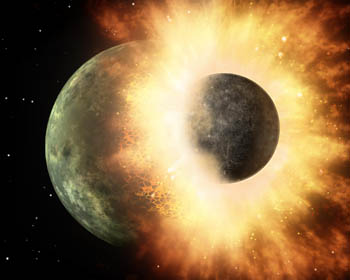Few things in life are as dependable as the Moon, yet the origin of this familiar companion is still shrouded in mystery. According to the leading theory, the Moon formed from the debris of a catastrophic collision between Earth and another body roughly the size of Mars. A new study, however, suggests another scenario: perhaps the Moon we see today isn't the Earth's first, but made up of several moonlets that formed from smaller collisions and eventually merged into one.

This artist's concept shows celestial bodies colliding. A similar collision could have produced our Moon. Image: NASA/JPL-Caltech.
Theories of the formation of the Moon are based on mathematics. If you know the correct equations you can calculate, or nowadays simulate on a computer, how different scenarios could have given birth to the Moon. It was Charles Darwin's son, George Howard Darwin, who came up with one such theory back in the late nineteenth century. According to Darwin, the Moon formed from molten material that was spun off the Earth by centrifugal forces as it turned around its own axis, aided by tidal forces coming from the Sun. Darwin used Newton's physics to calculate that, in the past, the Moon did indeed orbit much closer to the Earth, and that it is slowly moving further away from it now. He was right on that account — experiments performed by the Apollo 11 mission confirmed the Moon's drifting away from the Earth — but he couldn't prove that the Moon had indeed been part of the Earth at one point.
The idea that the Moon was formed by a single catastrophic impact, rather than a spinning away of Earth material, started to find acceptance in the 1970s. Today proponents of the giant impact or Big Splash theory believe that the collision happened around 4.5 billion years ago. The body which collided with the Earth is fittingly called Theia after the Greek titan and mother of the Moon goddess Selene.
But while there's good evidence to support the giant impact theory, there are also problems. In the 1980s computer simulations of the impact showed that the Moon would have been formed mostly from remnants of Theia, and should therefore have a chemical make-up very different from that of Earth: no other body in our solar system matches the Earth in its composition, so in all likelihood Theia didn't either. But the opposite is actually the case. Analyses of Moon rocks show that the Moon's composition matches that of the Earth's mantle, the layer that lies between its crust and its core. It seems, then, that the Moon was formed from Earth material, rather than the stuff of Theia, just as Darwin had suggested.
Scientists weren't ready to give up on the giant impact theory through. They have shown that more Earth material would have been flung into space if the early Earth was spinning much faster than it does today, or if Theia was larger than had previously been assumed, about the size of the Earth itself. In both cases a Moon as we know it today could have been formed, but both would have produced an Earth-Moon system spinning at a faster rate than the one we now observe. There are theories for what might have slowed the system down, but not everyone is convinced. What is more, other simulations have suggested that the system's current spin (and mass) might be the result of more than one impact.

The Moon tinted reddish during a lunar eclipse. Image: Alfredo Garcia, CC BY-SA 2.0.
It's this multiple impact idea that the new research picks up on. Hagai Perets, Raluca Rufo and Oded Aharonson ran 800 simulations to investigate possible impact scenarios and what they could mean for Moon formation. "Our model suggests that the ancient Earth once hosted a series of moons, each one formed from a different collision with the proto-Earth," says Perets. "It's likely that such moonlets were later ejected, or collided with Earth or with each other to form bigger moons."
The tidal forces of the Earth would have caused the small moons to move away from it and the gravitational influence of these moons on each other could have caused them to change their motion around the Earth. "It's likely that small moons formed through the process could cross orbits, collide and merge," says Rufo. "A long series of such moon-moon collisions could gradually build up a bigger moon — the Moon we see today." The researchers believe that this scenario, because it involves a slow evolution rather than a single collision under very specific conditions, is also more likely than a single giant impact.
The research was published in Nature Geoscience last week, and we'll have to wait and see how the multiple impact idea will be received by other Moon researchers. In the mean time the Moon will keep slowly moving away from Earth at a rate of around 3.8cm a year. But that's only as fast as a finger nail grows, so in our life times and beyond, the Moon will remain a steady companion.